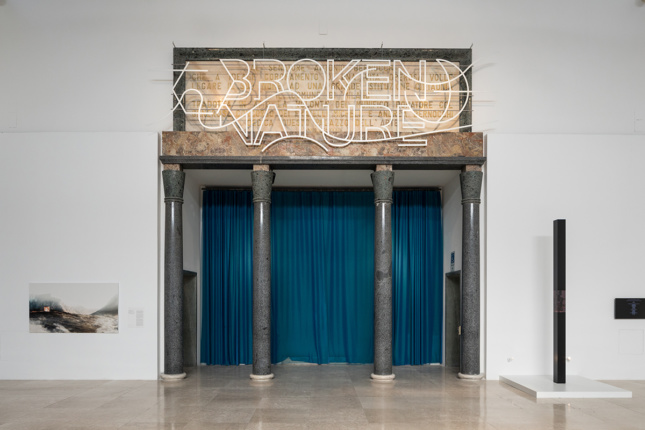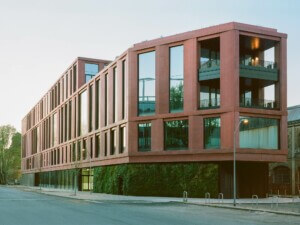The much anticipated Museo del Design Italiano opened its doors to the public in the same week in April as the Salone del Mobile.Milano. Housed in the storied Milan Triennale, this carefully assembled selection of design artifacts is curated by Joseph Grima, who began his tenure as the museum’s first director. This collection, housed in the Italian Design Museum, is a preeminent example, according to the Triennale Foundation’s president Stefano Boeri, of Italy’s rich post-war cultural heritage.
Grima’s formula for the permanent exhibition is to parcel the Triennale’s significant archive into limited sets or editions, that he characterizes as “episodes,” with the first episode serving as the premiere event. Episode 1 is a survey of the postwar years between 1948 and 1981 and is housed in the first half of the curved gallery that winds around the ground floor. Each progressive installment will expand deeper into the Triennale’s bowel-like interiors. The ultimate goal for the Design Museum is to expand beyond Giovanni Muzio’s original 1930s architectural masterpiece. The intention, according to Boeri, is for the museum to grow out by dipping below the rear gardens. An international competition for this future wing will soon be in the offing.
It should be pointed out, however, that the exhibition on Italian design is concurrent with, if only through a programming coincidence, a major traveling exhibition located on the second floor above: Broken Nature, curated by Paola Antonelli, the highly successful senior curator of architecture and design at MoMA. Subtitled Design Takes on Human Survival (open through September 1, 2019), this detailed survey of critical strategies dealing directly with the plight of the planet and its increasingly fragile ecosystems aims to be the last word on what is possible through human action in the fuzzy realm of the “technosphere,” a term coined by Peter Haff and adopted by Antonelli’s curatorial team. An impressive number of prominent international designers, thinkers, visual artists and craftspeople share the extensive second-floor space in a sprawling display of human invention and earthly ingenuity.

The two inadvertently overlapping exhibitions bring up the question of mutual relevancy, precisely because the similarities between these two exhibitions are much more marked than one would first assume. Looking at the two epochs under consideration, one postwar, the other very recent, both shows are reactions to extreme geopolitical contexts. Italy in the immediate postwar period had to overcome severe wartime devastation; while today, we are evidently firsthand witnesses to a ballooning climatic disaster.
Why push the comparison? Because Joseph Grima’s vision of the late fifties to the early eighties serendipitously provides us with a collection of object-time-capsules, or packaged narratives, where we come face to face with an Olivetti typewriter, a pair of Moonboots, a miniature Brionvega television set. These items are neatly arranged alongside related prototype wooden models, publications from promotional advertising campaigns, and in some cases original cardboard packaging. True, as Stefano Mirti, the Milanese designer and critic who was one of the earliest to comment on the exhibit over social media, put it, the objects are readied as if for Instagram shots, but Mirti also took great delight in the immediacy and directness with which these objects are allowed to communicate with us. The famed folding clamshell Grillo telephones, designed in 1965 by Marco Zanuso and Richard Sapper, are featured. Pick up the phone, try to remember or guess how to use the dial, and you are connected to the designer’s voice responsible for creating the object in front of you. It’s a pretty direct message, with no middleman.

Why is everyone still so mesmerized with this by-now relatively familiar collection of top Italian design objects? The something else that characterizes this permanent collection is the inherent irony, cynicism, and deep criticality that underlies almost each and every one of these impressive designs. What could possibly be the reason we are ensnared by Archizoom’s relatively uncomfortable looking Poltrona Mies chair built by Poltronova in 1969 to take just one example? Most of these pieces, developed with sparse financial support from the manufacturers, represent lengthy developments by trial and error, long personal commitments, and rare commercial successes—at least when they first came on the market. A case in point are the colorful names of these creations, Papillon, Rossocactus, Shanghai, Cucciolo, Trigger of the Space, Vertebra, Atollo, etc. The pieces are much more than merely functional objects; they act as totems for a new society.
Behind these designs are a nest of ideological structures that reject standardization, often embrace handcrafts and experimental materials, and evidently abandon the strict tenets of modernist rationalism. The pieces are in turn self-ironic, cynically auto destructive, or perversely inefficient. Enzo Mari is the master of this kind of design game, as so many of his pieces in this collection exemplify, like his Box from 1971 for Anonima Castelli, a chair that is its own carrying case, or his Modelli in scala Serie Proposta per autoprogettazione (Scale models for self-design Proposta series), 1973, for Simon International, conceived to empower the user to rethink one’s own domestic environment. The transition from postwar reconstruction to the threat of nuclear annihilation remains all the while a running subtext among these objects.

Looking at Broken Nature, one could only hope that there would be an equivalent level of meta-awareness. To be honest, several of the featured designers and creative thinkers in this exhibit do reach these heights, but they are drowned out by the sheer volume of participants. There are the overarching (or overreaching) categories, including “A Changed Climate,” “Complex Environments,” “Made and Unmade,” “More of the Times,” and “Bridges,” and some truly great projects for sure: beginning with the exhibition’s graphic icons, designed by Anna Kulachek. There are many impressive designs, fluent in the parametric, the biomimetic, the diagram, the transgenderative, the playful, but at the end of the day, what can you take away from all these projects, besides a deeply unrequited experience?
This is not to slight the many amazing designs featured in Broken Nature, but it calls to question the primary curatorial position, which attempts to be so all-inclusive that there remains little room for personal absorption or reflection on the part of the viewer. There is no way to digest all this comprehensive information into a personal action, or to urge us on as individuals to become more aware or rebellious. The lack of self-reflection, self-criticism, or even some kind of cynical self-abdication leaves the viewer with simply too much useful information to process. Broken Nature is not the only one among these hugely impressive, uber-intelligent, mega-exhibits to come on the circuit in these recent years. But I fear the effects are ultimately counterproductive. In a way, we become frustrated in our attempts to make sense of these works. Go downstairs, to the Museo del Design Italiano, to experience how irony, satire, and self-deprecation draw your curiosity and fuel your imagination. This is what we need more of today.











